More and more beautiful annuals are appearing in gardens and personal plots. One of the favorites among beautiful flowering annuals is verbena. Flower growers like it for its ease of planting and care. Amateur photographers enjoy photographing flower arrangements with verbena.
Description of verbena and photo of flowers
Verbena, a member of the verbena family, is native to South America, where 250 species grow.The culture is represented by annual or perennial plants up to 1 m high. Many of these species are found only in their homeland. But there are species that have taken root well in the climatic zones of our country.
The stems of verbena are straight, spreading or creeping, smooth or pubescent. The leaves have a variety of shapes. The root system is fibrous. Inflorescences appear in June in the form of panicles or umbrellas, consisting of 35-60 buds, blooming alternately. The flowers are sessile, with a pleasant delicate aroma, quite small (1.5 - 2.5 cm in diameter). The photographs show that the shape of the flowers resembles small carnations. Flowering continues from the beginning of June until the end of October.
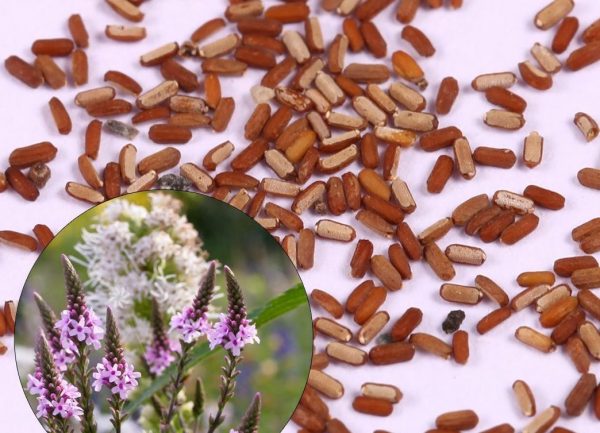
Seeds remain viable for up to 5 years.
The fruit is a nut, divided into 4 parts. The seeds are so small that 1 g can contain up to 300 seeds. Depending on the type, germination lasts from 2 to 5 years.
The plant prefers light and warmth. Loves light, moderately fertile soil with neutral acidity. All species are drought-resistant, tolerate light frosts up to 3 C. Therefore, verbena can overwinter in open ground only in the southern regions, and in mid-latitudes it is grown in garden plots as an annual, or in flower pots in a winter garden or room.
The flowers of the culture are represented by a wide palette of shades of blue, purple, red, yellow, and white. Petals can be one color or have a light center.
Varieties of verbena
The appearance of the plant depends on what species and variety it belongs to. The variety of shapes and colors is clearly visible in the photo.
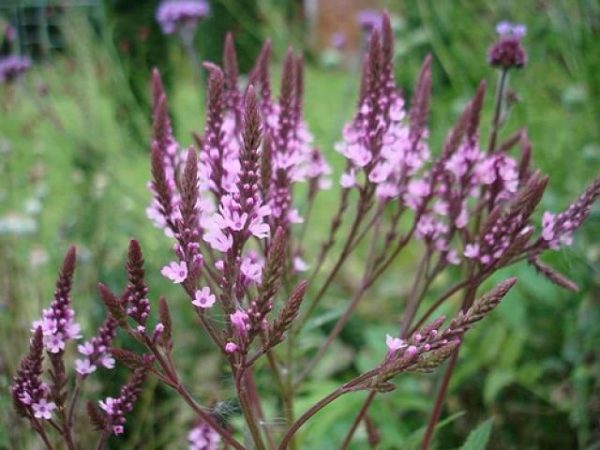
verbena pryamaya
Verbena straight - the only cultivated variety that winters in the middle zone. It has elongated oval leaves, lilac flowers and short flowering.
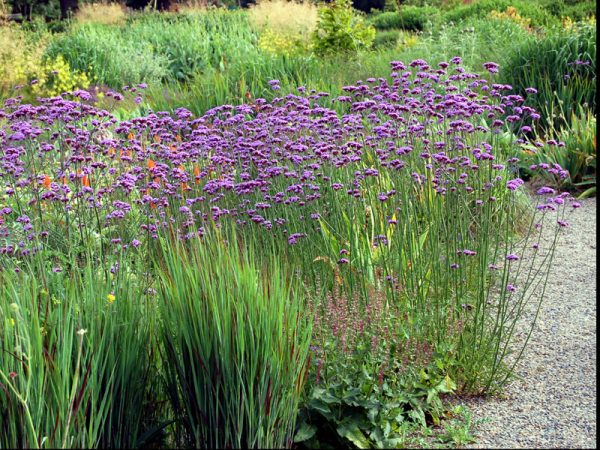
Verbena buehnos-ajresskaya
Verbena Buenos Aires It is distinguished by tall, straight stems (120 cm), from the base of which side shoots extend. This species is characterized by long, serrated leaves, small flowers of a lilac hue, collected in spikelets. Flowering is abundant and long lasting.
Verbena hybrid
Hybrid verbena is a priority among gardeners. Thanks to selective work, many varieties with distinctive characteristics have been developed. Such as the height of the plant, the size of the flowers, the color of the petals, the presence of a central eye and its shape. Hybrids bloom from June to October. In the sun the flowers fade slightly.
Verbena hybrid is divided into subspecies: large-flowered, compact.
For large-flowered (or mammoth) verbena is characterized by a height of up to 50 cm, inflorescences with a diameter of 5-7 cm. The shoots spread along the ground, rising with their crowns up.
Varieties representing the species:
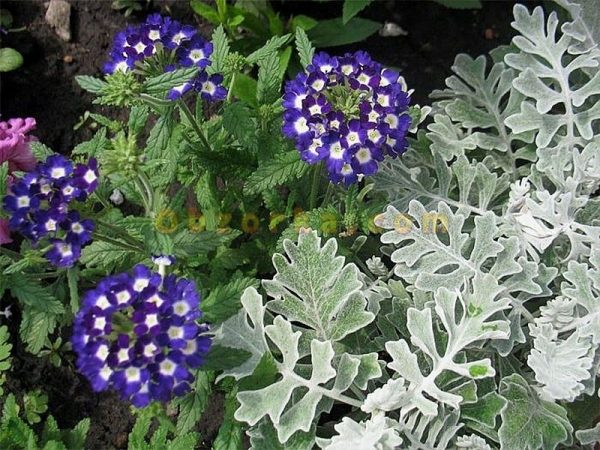
Verbena ciklop
Cyclops - with deep blue flowers and a white eye in the center;
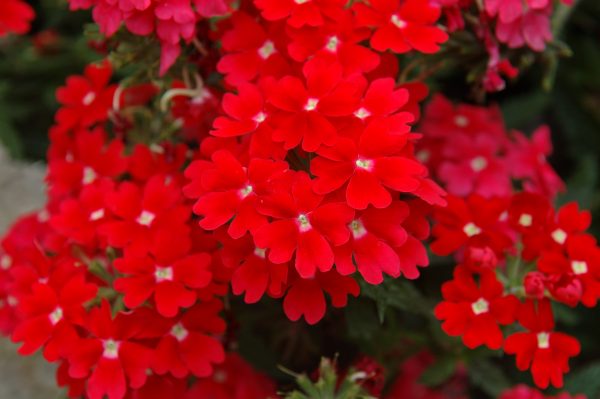
Verbena ehtna
Etna - with fiery red flowers with a large cream-colored star-shaped eye, blooming in May;
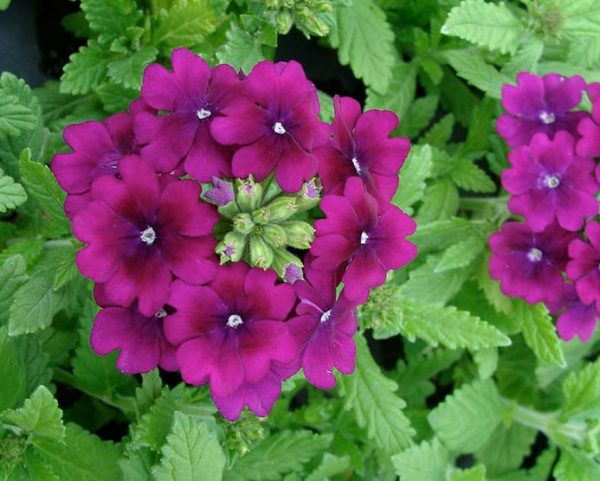
Verbena Quartz XP Purple
Verbena Quartz XP Purple — flowers with a deep purple color that fades slightly towards the edge of the petals. Suitable for growing in containers.
Verbena low (compact)
A low-growing species (20-30 cm) with short shoots and dense inflorescences. Typical varieties:
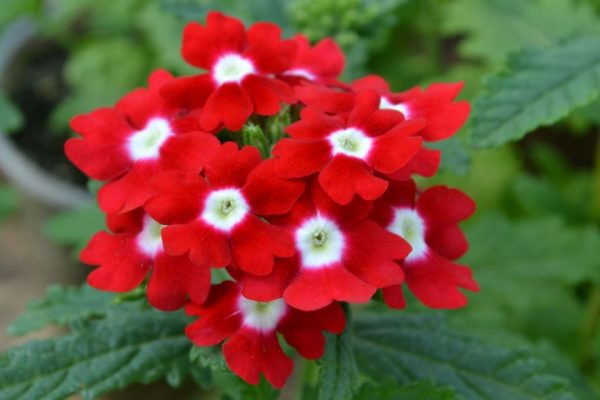
Verbena Defiance
Defiance - with carmine-red flowers with a beautifully shaped yellow-greenish eye;
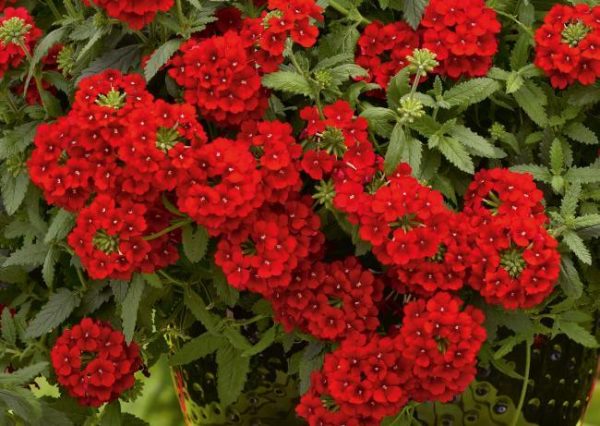
Pictured is Hem Zaden
Red large-flowered producer Hem Zaden (Netherlands) - a plant about 20 cm high, the flowers are dark red, velvety;
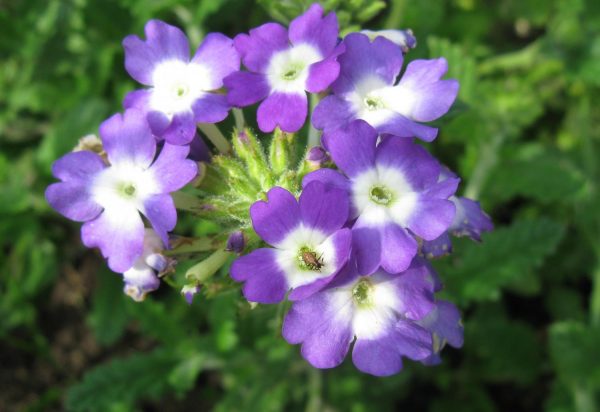
Amethyst
Amethyst - differs in the original color of the flowers - blue with a white eye;
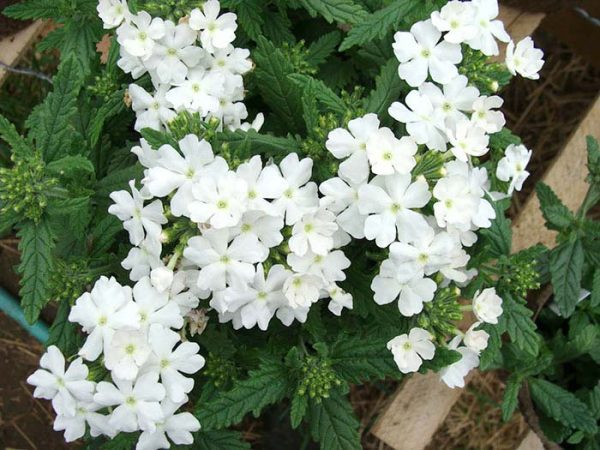
Verbena Kvarc
Quartz XP White, hybrid - early flowering, white flowers, height - 20 cm;
Lady Dream - bright pink blooms with a pleasant smell. Compactness and good branching distinguish this plant from others. Lady Dream blooms until frost.
A series of varieties have been created that combine flowers with the same flowering time and similar appearance, resistant to fungal diseases and pests. The only differences within the series are the coloring. The flowers of the Temari series are unpretentious in care, bloom luxuriantly and are resistant to powdery mildew. Flowers of the Tapien series are propagated only by cuttings, branch intensively, bloom long and abundantly, are resistant to powdery mildew, and are unpretentious.
The Novalis and Romeo series include low-growing varieties, no higher than 20 cm.
Verbena tough
This variety is characterized by long, dense leaves with a sharp top, with convex veins, and fleecy underneath. The flowers are only 1 cm in diameter, violet or purple. Flowering is abundant. Seeds remain able to germinate for up to 5 years.
Verbena canada
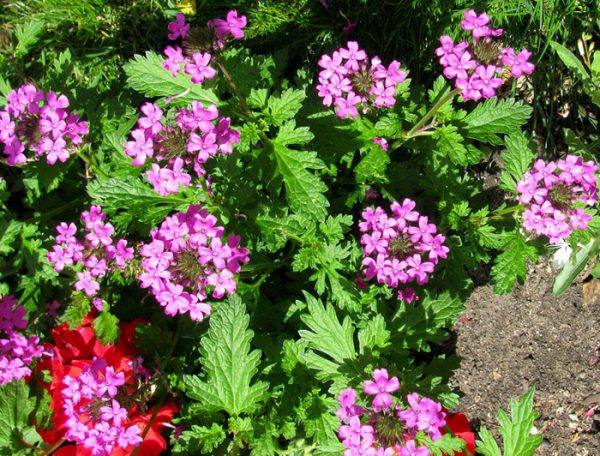
Verbena kanadskaya
Compact species with pink, white, purple blooms. The stems are thin, graceful, 15-20 cm long. The shape of the leaves is oval, elongated with a pointed tip. Flowering is long, from June to late autumn.
Verbena ampelous
The hardy variety comes in a wide range of colors. As it grows, it forms lush, bright flower caps. The leaves are openwork, decorative. The flowers are smaller than other species, but flowering is more abundant.
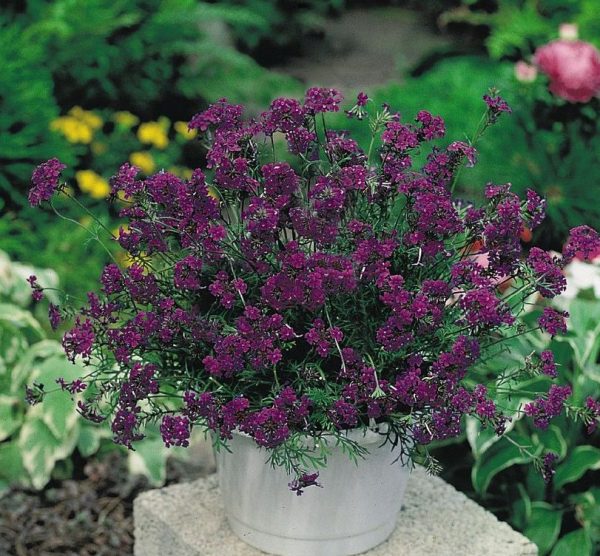
Verbena Imagination
Imagination - flowers of blue-lilac shades, form voluminous bushes up to 0.5 m in height and width. Cold-resistant, drought-resistant plant.
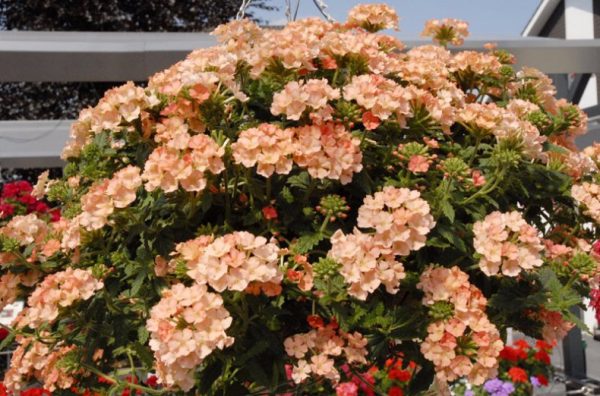
Verbena Empress Peach
Empress Peach - delicate creamy inflorescences. Flowering from June to October.
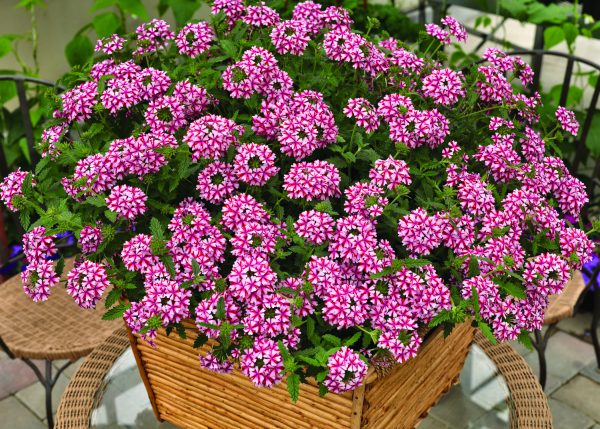
Verbena Lanai Candy Cane
Lanai Candy Cane - early flowering, large flowers.

Verbena Estrella Voodoo Star
Estrella Voodoo Star - large red and white inflorescences. Height – 30 cm. Flowering continues from June until frost. Drought-resistant variety.
Growing verbena from seeds
Traditional propagation of verbena is by seed. Varieties that do not produce seeds are propagated by cuttings. Flowering occurs after 50 -70 days, so experienced gardeners prefer seedling method. It is better to sow seeds for seedlings from early to mid-March. During this period, the seedlings have enough natural light.
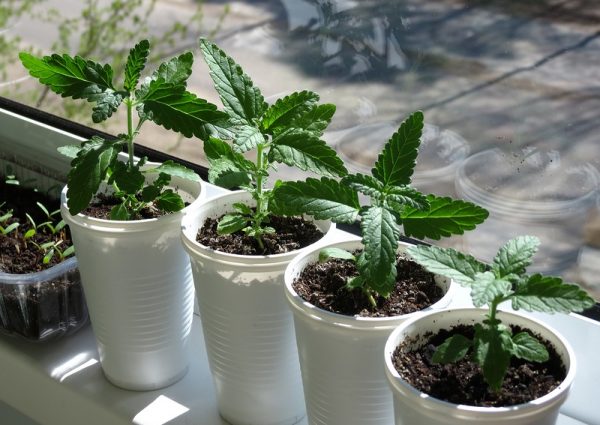
Growing verbena from seeds
For seedlings you will need loose, drained soil with neutral acidity. To ensure good moisture and air permeability of the soil, add a handful of perlite to each liter of soil mixture.
The seeds are distributed over the surface of the soil and moistened with a spray bottle. Cover with glass and place in a warm place. Shoots appear unevenly and take a long time, up to a month.
Advice! To stimulate uniform and friendly shoots, the seeds are soaked in a biostimulant solution.
When seedlings appear, the container is moved to a cooler place (14-16 degrees). Lighting must be sufficient.
Seedlings dive when 3 - 4 true leaves appear. The seedlings are buried to the level of the first pair of leaves. Seedlings need to be fertilized once every 14 days with seedling fertilizer. In ampelous varieties, pinch off the top.
Rules for planting seedlings in the ground
The cold resistance of the crop allows it to be planted in open ground in the second ten days of May. Before planting seedlings, the soil is dug up, adding 1 square meter. m 1.5 tbsp. l. complex mineral fertilizer.
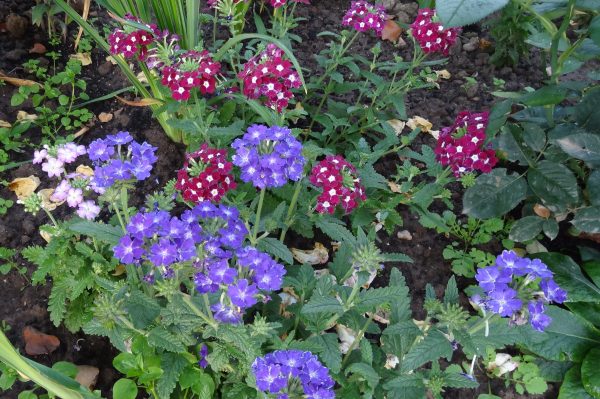
Planting verbena in the ground
The distance between seedlings is maintained from 25 to 45 cm.To retain moisture in the soil, plantings are mulched with peat.
Caring for flowers in the garden
Being an unpretentious plant, verbena requires the fulfillment of certain conditions that have a beneficial effect on the growth and flowering of the crop. If the creeping shoots are pinned to the ground, they will sprout roots and the bushes will become more luxuriant.
Important! Faded inflorescences should be removed to allow the plant to set new buds. Otherwise, the plant will slow down flowering and begin to form seeds. Some of the inflorescences are left in case it is necessary to prepare seeds.
Watering
Moderate watering is required. When there is excess moisture, verbena is affected by powdery mildew. If there is a lack of moisture, the plant stops blooming and begins to form seeds.
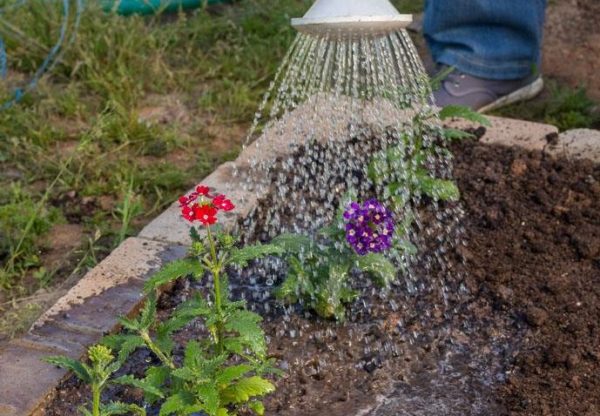
Verbena care
Top dressing
An excess of nitrogen fertilizers provokes the growth of green mass, but inhibits flowering. The same effect comes from organic fertilizers. Young plants are fed with solutions of complex mineral fertilizers. For 1 sq. m, it is enough to add 30-40 g. From the second half of July, phosphorus-potassium fertilizers are mainly used. During the season it is necessary to carry out 3 - 4 feedings.
Diseases and pests
Diseases do not bother verbena. Infection with powdery mildew can be caused by errors in care and prolonged rains.
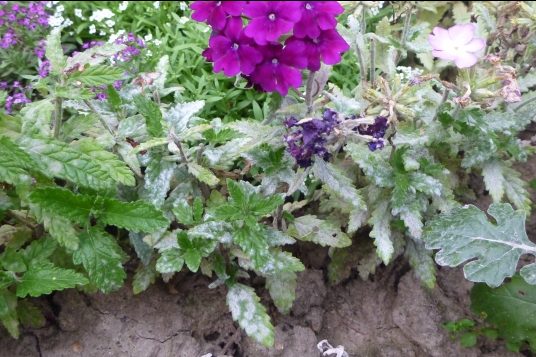
Powdery mildew
Fungicides are used for treatment: Topaz, Fundazol. Aphids and spider mites are controlled using insecticides or insectoacaricides.
Features of growing ampel verbena
Among all the variety of types and forms, it is considered especially popular ampelous verbena, despite the fact that its flowers are smaller and have no aroma. The plant compensates for this deficiency with abundant flowering.The photo shows that the petals are most often colored red, pink, purple, blue, and white.
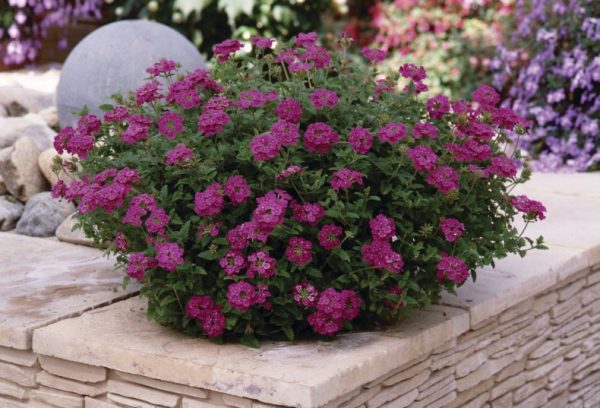
Ampel verbena
The agricultural technology for caring for the ampelous form is almost no different from caring for other species. For example, it requires more intensive nutrition than upright species.
Important! To preserve and retain moisture in hanging planters, peat, moss or coconut fiber is placed at the bottom of the container. These materials gradually release moisture to the plant.
Propagation by cuttings
Varieties of ampelous verbena that do not form seeds can be propagated by cuttings. The plant for cuttings is stored in a room with a temperature of +5-+10 degrees. The cutting procedure begins in early March. The soil mixture is made up of peat, agroperlite and sand.
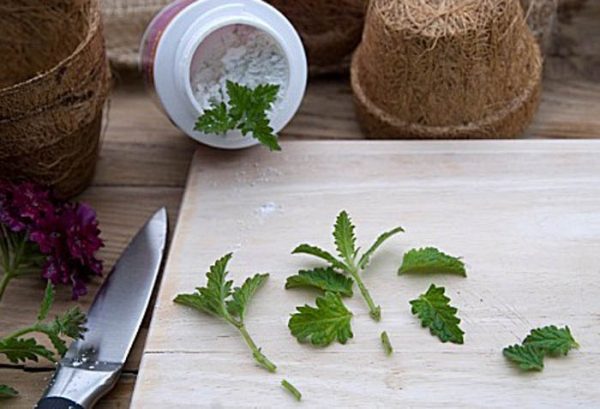
Verbena propagation by cuttings
For cuttings, use the upper part of the shoots with 3-4 internodes. Leave 2-4 leaves on the shoot to reduce moisture evaporation. The lower cut of the stem is treated with Kornevin and planted in seedling boxes. The plantings are placed in a mini greenhouse and ventilated regularly. In a month, roots will appear. The seedlings are transplanted into open ground in May-June.
Using verbena in garden design
The widespread cultivation of bright flowers in personal plots is due to the attractive appearance of bright inflorescences. Verbena is a universal plant for decorating flower beds and flower beds. Various varieties with original colors will fit perfectly into compositions with other flowers.
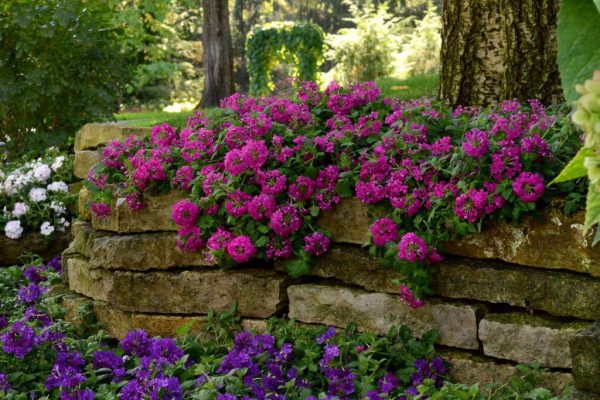
Photo of verbena in the garden
This culture looks equally organic in composition with exquisite roses or among wildflowers. Chamomile, cornflower, verbena, calendula and other low flowers will create a Moorish-style lawn.The classic combination of lavender, verbena with rosemary, thyme, and sage will form the basis for a Tuscan flower garden.
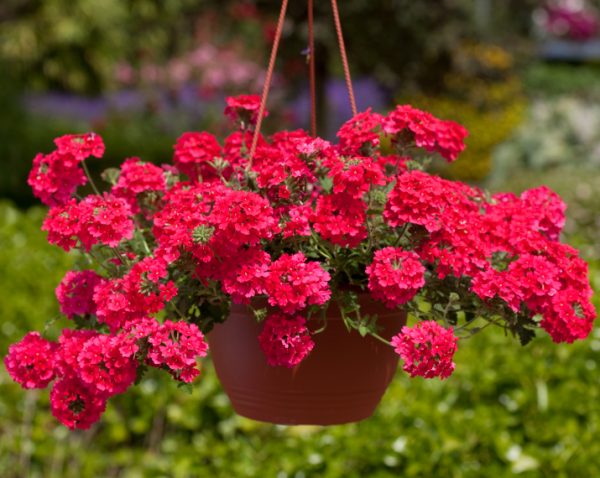
Ampelous verbena in a flowerpot
Ampel verbena is universal; it can be used both for planting in hanging pots and for planting in groups in a flower bed. Hanging varieties are indispensable when decorating balconies, terraces and gazebos in the form of hanging flowerpots. Flowering openwork shoots gracefully hang down, forming a multi-colored or monochromatic flowering ball. In flower beds, hanging varieties are organically combined with ornamental grasses, liastris, asters, lobelias and Tagetis. Examples of combining verbena with various crops are presented in the pictures.
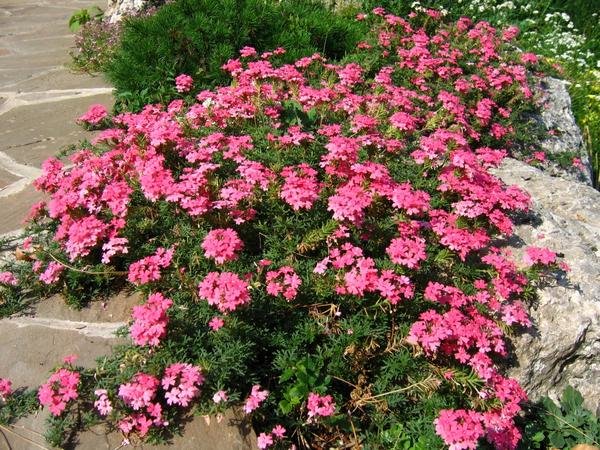
Low-growing varieties are used as ground cover plants
Low growing varieties crops are planted as a border, or shrubs are lined with them. Creeping varieties are used to create flowering waterfalls flowing among stones. They are perfect for alpine slides. They are often used as ground cover among irises, daylilies or any tall flowers. The combination of compact varieties in blue tones surrounded by white looks elegant. alyssum.
Tall varieties look great in the background of flower beds, shading dwarf zinnia, gazania, heliotrope.
Varieties of the Temari and Tapien series used as ground cover when decorating flower beds in open ground. They are no less good in hanging pots on their own or in composition with other hanging crops. These varieties are suitable for replanting with large tub crops. Representatives of the Novalis series are used for carpet landscaping.
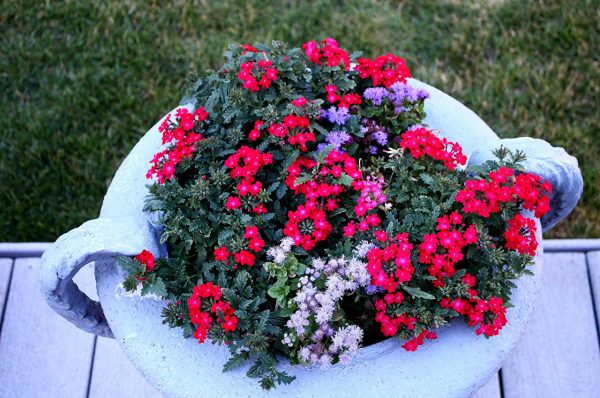
Verbena in the garden
Having once planted verbena, gardeners become fans of it for a long time.The variety of varieties and shapes does not allow flowers to get boring, and during flowering the hand itself reaches for the camera to capture the luxurious bloom in photographs.
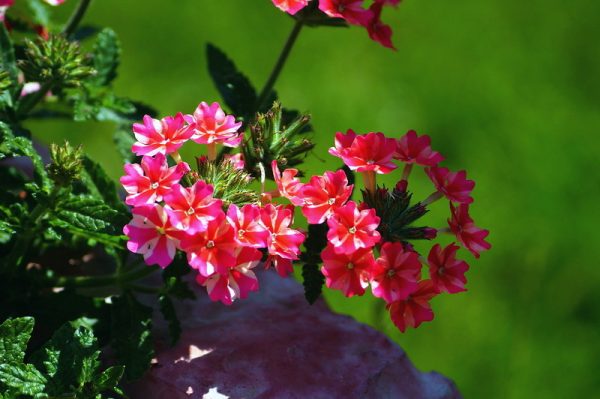
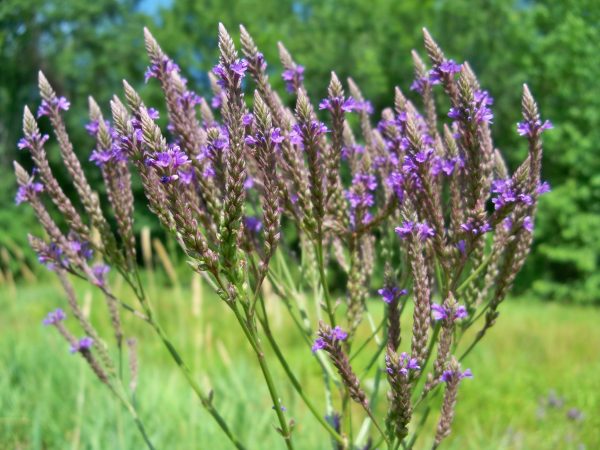
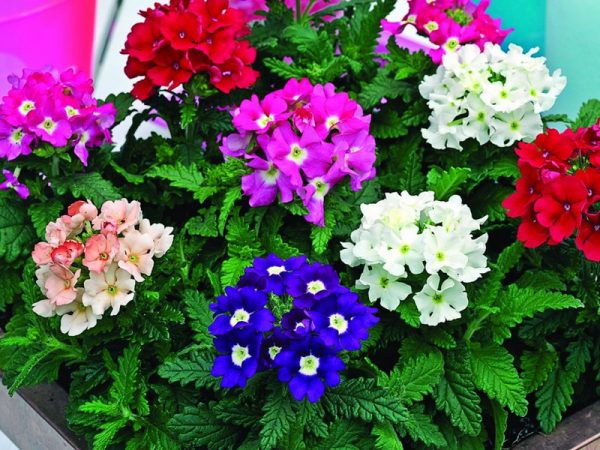
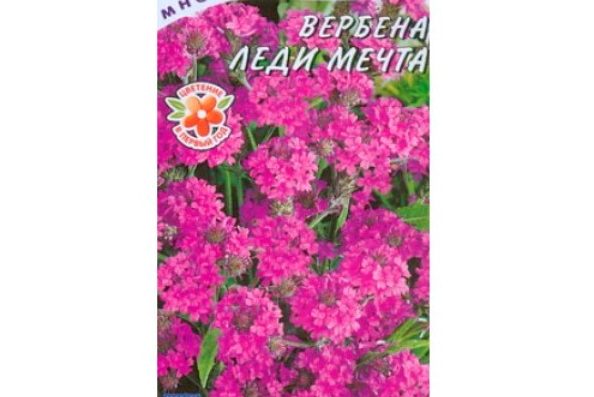
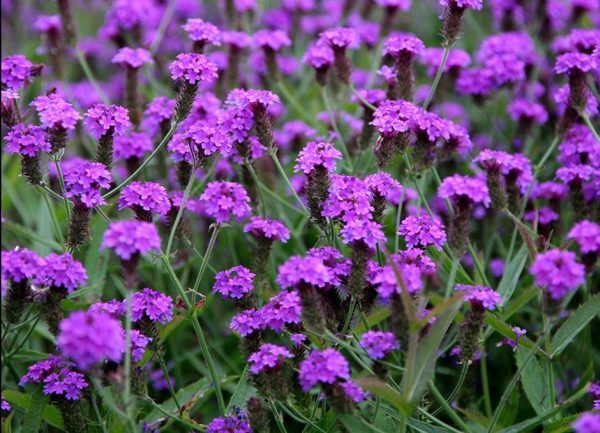
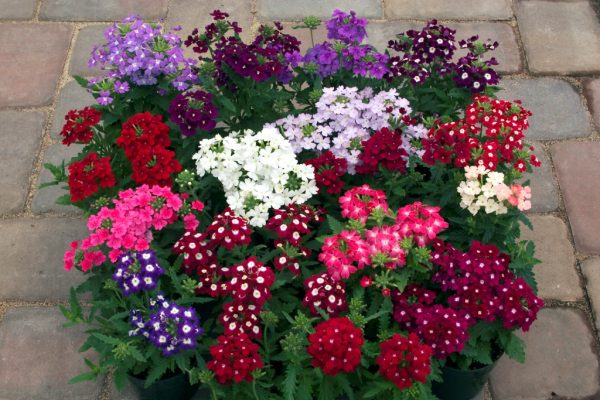

 CUCUMBERS NEVER GET SICK, I'VE BEEN USING ONLY THIS FOR 40 YEARS! I SHARE A SECRET WITH YOU, CUCUMBERS ARE LIKE THE PICTURE!
CUCUMBERS NEVER GET SICK, I'VE BEEN USING ONLY THIS FOR 40 YEARS! I SHARE A SECRET WITH YOU, CUCUMBERS ARE LIKE THE PICTURE! You can dig a bucket of potatoes from each bush. Do you think these are fairy tales? Watch the video
You can dig a bucket of potatoes from each bush. Do you think these are fairy tales? Watch the video
 How our fellow gardeners work in Korea. There is a lot to learn and just fun to watch.
How our fellow gardeners work in Korea. There is a lot to learn and just fun to watch. Eye trainer. The author claims that with daily viewing, vision is restored. They don't charge money for views.
Eye trainer. The author claims that with daily viewing, vision is restored. They don't charge money for views. A 3-ingredient cake recipe in 30 minutes is better than Napoleon. Simple and very tasty.
A 3-ingredient cake recipe in 30 minutes is better than Napoleon. Simple and very tasty. Therapeutic exercises for cervical osteochondrosis. A complete set of exercises.
Therapeutic exercises for cervical osteochondrosis. A complete set of exercises. Which indoor plants match your zodiac sign?
Which indoor plants match your zodiac sign? What about them? Excursion to German dachas.
What about them? Excursion to German dachas.